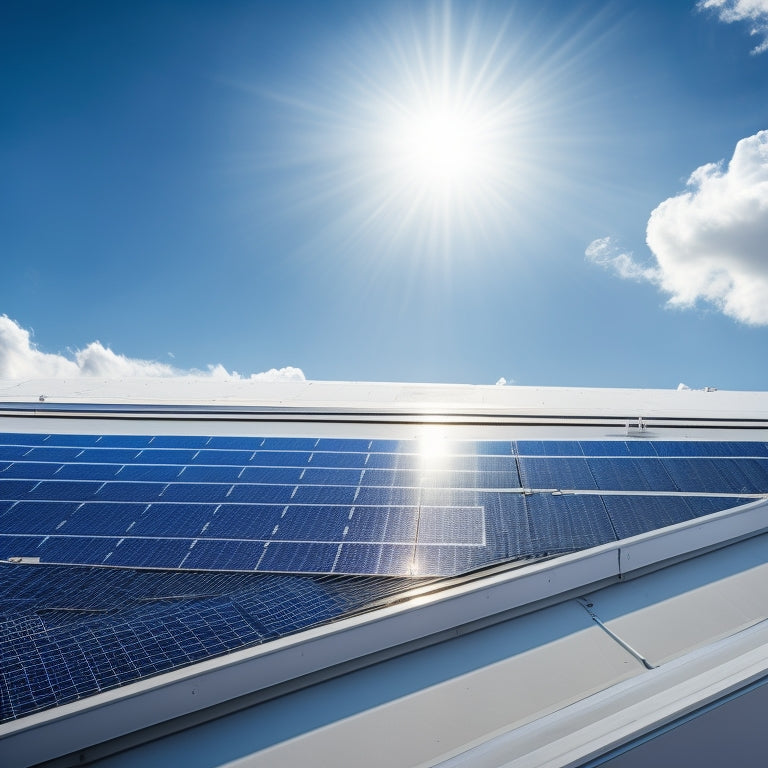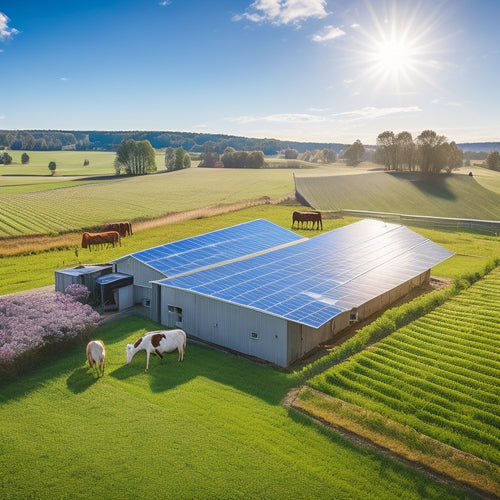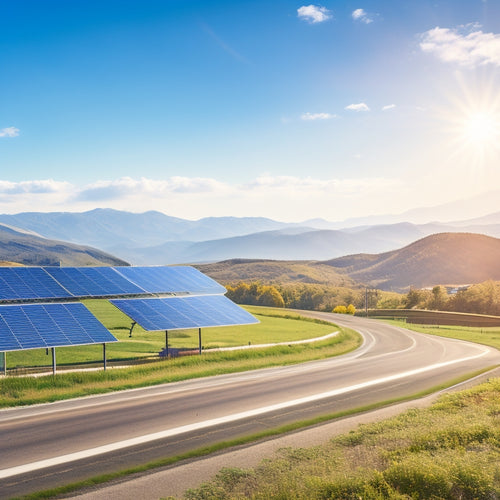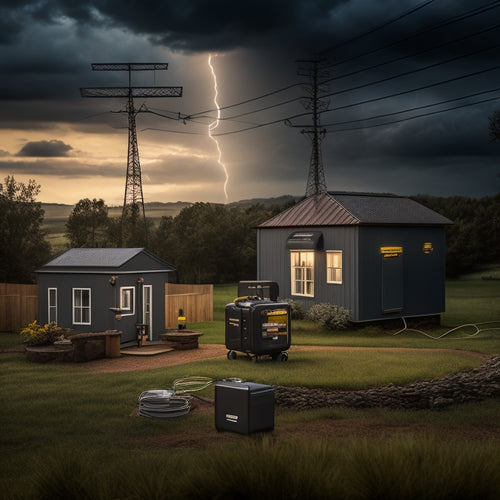
Solar Power Systems Prices
Share
You can expect to pay between $15,000 and $30,000 for a typical residential solar power system, although prices vary depending on factors like system size, panel efficiency, and installation requirements. Your investment will yield significant energy savings, with solar power reducing your energy bills substantially and providing a predictable monthly expense. To maximize your system's potential, you'll need to evaluate your roof size, orientation, and shading, as well as government incentives like the Federal Tax Credit. By understanding these key factors, you'll be well-equipped to make an informed decision about your solar power system - and access the full benefits of clean, renewable energy.
The Essentials
- Solar power systems utilize free solar energy, significantly reducing energy expenses and providing affordable residential solar panel prices.
- Energy bills decrease substantially with solar power, leading to increased energy savings and substantial investment returns.
- Predictable monthly bills allow for greater control over energy costs, with typical expenses including loan repayments, maintenance, insurance, and energy consumption.
- A 26% Federal Tax Credit is available for solar system adoption, with additional state and local incentives applicable for further savings.
- Factors like roof size, space availability, and orientation impact the overall cost and efficiency of solar power systems, making assessment crucial for accurate pricing.
Zero Carbon Footprint Guaranteed
You're likely considering solar power systems because you want to reduce your carbon emission reduction and invest in eco-friendly energy solutions.
By choosing solar power, you'll be producing clean energy that doesn't contribute to climate change.
As you investigate renewable energy solutions to power your residential home, you'll find that solar power for house solutions address common challenges such as rising electricity bills and environmental impact Renewable Energy for Homes.
With a zero-carbon footprint guarantee, you can rest assured that your decision will have a positive impact on the environment.
Carbon Emission Reduction
Carbon emission reduction is a critical component of solar power systems, as they offer a reliable means of generating electricity while producing zero emissions.
You're not only reducing your reliance on fossil fuels but also contributing to a cleaner environment. By investing in solar power, you're taking a significant step towards minimizing your carbon footprint.
In fact, residential renewable energy solutions like Home Solar Installation can help homeowners save money on their electricity costs and reduce their dependence on the grid.
Additionally, solar power systems provide a sustainable energy alternative to traditional fossil fuels.
To further amplify the impact, you can investigate carbon offset strategies.
These strategies involve offsetting the emissions produced by your daily activities, such as driving or flying, by investing in projects that reduce greenhouse gas emissions elsewhere. This guarantees that your overall carbon footprint remains neutral.
Solar power systems provide a sustainable energy alternative to traditional fossil fuels.
By utilizing the energy from the sun, you're reducing your dependence on finite resources and lowering your energy costs.
With solar power, you're not only reducing your carbon emissions but also gaining energy independence.
Eco-Friendly Energy Solutions
What's the most effective way to guarantee a zero-carbon footprint in your energy consumption? The answer lies in adopting eco-friendly energy solutions that utilize renewable energy sources, such as Sustainable Power Solutions for residential properties.
By integrating sustainable practices into your daily life, you can greatly reduce your reliance on fossil fuels and minimize your environmental impact. Many homeowners struggle with expensive and unpredictable energy costs, but renewable energy systems can provide a cleaner and more cost-effective approach.
Investing in solar power systems is a great starting point. These systems convert sunlight into electricity, providing a clean and sustainable source of energy. You can also investigate other renewable energy options, such as wind power or geothermal energy, depending on your location and energy needs.
To further reduce your carbon footprint, consider implementing energy-efficient solutions in your home or business. This can include installing LED lighting, energy-efficient appliances, and smart thermostats that optimize energy usage.
Low Operating Costs Guaranteed
You'll enjoy reduced energy expenses with solar power systems, as they utilize free energy from the sun to power your home or business.
With the average cost of single solar panels for homes being relatively affordable, residential solar panel prices can fit into your budget, making it easier to shift to renewable energy.
This means you'll see significant savings on your energy bills, providing a welcome increase to your bottom line.
With a solar power system, you'll also benefit from predictable monthly bills, giving you greater control over your energy costs.
Reduced Energy Expenses
Your energy bills will plummet with a solar power system, which translates to significant savings over time. As you generate your own clean energy, you'll rely less on the grid, reducing your energy expenses substantially.
This, in turn, means you'll enjoy increased energy savings, which will add up to substantial investment returns over the system's lifespan.
With a solar power system, you'll lock in a low rate for energy, shielding you from rising electricity costs. This predictable energy cost structure allows you to better manage your finances, freeing you from the uncertainty of escalating energy bills.
As the system pays for itself, you'll reap the benefits of your investment, enjoying a higher degree of financial freedom. By utilizing the power of the sun, you'll reduce your energy expenses, increase your energy savings, and reap the rewards of a smart investment.
Predictable Monthly Bills
By virtue of their design, solar power systems operate with minimal moving parts, ensuring low maintenance requirements and negligible repair needs, which in turn guarantee low operating costs on a monthly basis. This means you can enjoy predictable monthly bills, freeing you from the uncertainty of rising energy expenses. With a solar power system, you can accurately forecast your energy costs, making budget planning a breeze.
Here's a breakdown of the typical monthly costs associated with solar power systems:
| Cost Component | Monthly Cost |
|---|---|
| Loan repayment | $100-$200 |
| Maintenance and repairs | $10-$50 |
| Insurance | $20-$50 |
| Energy consumption (if applicable) | $50-$100 |
As you can see, the monthly costs are relatively low and easily manageable, allowing you to allocate your resources more efficiently. With solar power, you can rest assured that your energy expenses will remain stable, giving you the freedom to focus on what matters most to you.
Maximum Energy Output Guaranteed
You'll want to maximize your energy output to get the most out of your solar power system. This is achieved through high-efficiency panel technology, which converts sunlight into electricity at a higher rate than traditional panels.
With top-ranked high-efficiency solar panels, such as Monocrystalline and PERC, you can guarantee maximum energy output.
High-Efficiency Panel Technology
Efficiency is the cornerstone of a reliable solar power system, and high-efficiency panel technology is the key to releasing maximum energy output. You want to utilize as much energy as possible from the sun, and high-efficiency panels are designed to do just that. With advanced solar technology, these panels boast higher panel efficiency, ensuring you get the most out of your solar power system.
| Panel Type | Efficiency Rate | Energy Output |
|---|---|---|
| Standard | 15-17% | 250-270 Watts |
| High-Efficiency | 20-22% | 300-330 Watts |
| Premium | 24-26% | 350-380 Watts |
Optimal System Configuration
Most solar power systems can be refined to achieve maximum energy output, and it's vital to get the configuration right. When you're designing a solar power system, you need to take into account your energy needs and determine the best system size to meet those needs. A system that's too small won't provide enough power, while one that's too large will be a waste of resources.
To achieve the best system configuration, you'll need to assess your energy usage patterns and determine the peak demand periods. This will help you determine the required system size and the number of panels needed.
It's also important to take into account the orientation and tilt of the panels, as well as the type of mounting system used. Proper configuration guarantees that your system operates at maximum efficiency, generating the most energy possible while minimizing costs.
Consider Your Roof Size
When evaluating a solar power system, you need to assess your roof's space availability to determine the maximum number of panels it can accommodate.
Residential solar panels can be installed on various roof types, including asphalt shingles, metal, and clay tiles renewable energy systems.
You'll also want to evaluate your roof's orientation, as an ideal south-facing roof with minimal shading will maximize energy production.
Additionally, it's crucial to take into account energy efficiency solutions to optimize your system's performance.
Roof Space Availability
A typical residential solar power system requires around 200-300 square feet of roof space to generate 5 kilowatts of electricity.
When evaluating your roof's availability for solar panels, you'll need to assess its size and style. A larger roof with a simple, rectangular shape is ideal, as it can accommodate more panels. However, if you have a complex roof with multiple skylights, vents, or turrets, you may need to adjust your system design to work around these obstacles.
Shading factors also play a vital role in determining your roof's suitability for solar panels. Take note of any trees, chimneys, or neighboring buildings that could cast shadows on your roof.
Even partial shading can greatly reduce the system's efficiency, so it's important to evaluate these factors when assessing your roof's space availability. Be prepared to provide your solar panel installer with detailed information about your roof's size, style, and shading conditions to guarantee an ideal system design that meets your energy needs.
Ideal Roof Orientation
With your roof's size and style assessed, it's now vital to evaluate its orientation, a pivotal factor in utilizing ideal solar energy. The ideal roof orientation for solar panels varies depending on your location and the time of year. In the northern hemisphere, a south-facing roof is optimal, as it receives the most direct sunlight throughout the year. However, if your roof faces east or west, you can still generate considerable solar energy, albeit with some loss of efficiency.
The roof angle also plays an important role in energy production. A roof angle between 30° and 40° is regarded as ideal, as it allows for the most efficient energy generation while minimizing shading effects. If your roof has a steeper angle, you may need to adjust the solar panel's tilt to compensate for the reduced energy output.
When evaluating your roof's orientation, consider any potential shading effects from nearby structures, trees, or other obstructions. Even partial shading can greatly reduce your solar panel's energy output, so it's vital to assess these factors before installing your solar power system.
Government Incentives Available Now
You'll be pleased to know that the US government offers a Federal Tax Credit to encourage the adoption of solar power systems.
This incentive allows you to claim a credit of 26% of the total cost of your solar power system against your federal income taxes.
Federal Tax Credit
The federal government's commitment to renewable energy is evident in the Federal Tax Credit, a lucrative incentive designed to encourage homeowners and businesses to invest in solar power systems. As a homeowner or business owner, you can greatly reduce your tax liability by claiming a credit of 26% of your total solar power system cost. This federal incentive can be claimed in addition to state and local incentives, further increasing your tax savings.
| Year | Tax Credit Percentage | Eligibility |
|---|---|---|
| 2020-2022 | 26% | Residential and Commercial |
| 2023 | 22% | Residential and Commercial |
| 2024 and later | 10% | Commercial only |
Frequently Asked Questions
Can I Install Solar Panels on a Metal or Tile Roof?
You can install solar panels on a metal or tile roof, but you'll need to verify roof compatibility and adapt installation techniques, such as using specialized mounting systems or additional sealing measures to confirm a secure and waterproof fit.
How Long Does It Take to Install a Solar Power System?
You're wondering how long it takes to install a solar power system? Consider a typical residential installation, like the Smiths' 5-kilowatt system, which took 3-5 days to complete, following a standard installation timeline and process that involves assessment, permitting, and setup.
Are Solar Panels Resistant to Extreme Weather Conditions?
You'll be relieved to know that solar panels are indeed designed to withstand extreme weather conditions, boasting durability and resilience that guarantees consistent energy output, even in the face of harsh environmental factors like intense winds and heavy snowfall.
Can I Monitor My Solar Power System's Performance Remotely?
You can remotely monitor your solar power system's performance in real-time, tracking key metrics like energy production, consumption, and system health, ensuring you're always in control and maximizing your energy independence.
Do Solar Panels Require Regular Cleaning and Maintenance?
You'll need to clean your solar panels regularly to maintain their efficiency, but the cleaning frequency depends on your location and climate; factor in maintenance costs, typically around $300 annually, to guarantee peak performance and energy freedom.
Final Thoughts
By investing in solar power systems, you'll reap a triple whammy of benefits: zero carbon footprint, low operating costs, and maximum energy output. With considerations like roof size and government incentives in your favor, the payoff is undeniable. Welcome the future of clean energy and start saving today - your wallet and the planet will thank you!
Related Posts
-

What Do I Need to Know About Farm Solar Panels
When considering farm solar panels, you need to assess costs, benefits, and technical specifics. Initial investment c...
-

Is Switching to Green Energy Solutions Easy
Switching to green energy solutions isn't just easy; it's also beneficial. You can greatly cut utility costs and enjo...
-

Key Components of a Reliable Emergency Power Supply System
A reliable emergency power supply system requires several key components. You need proven performance metrics to guar...


